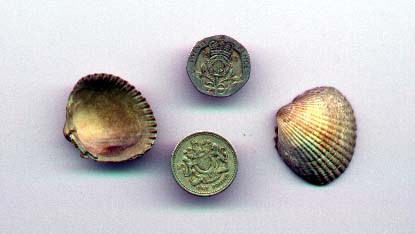
 |
Cockles from around
the British Isles.
Top: the small
specimen is the Lagoon Cockle,
Cerastoderma glaucum.
Middle: the
Common Cockle, Cerastoderma edule.
Bottom: the Prickly
Cockle, Acanthocardia echinata.
Family Cardiidae
Acanthocardia J E Gray, 1851
Acanthocardia
aculeata (Linnaeus, 1758)
Acanthocardia
echinata (Linnaeus, 1758)
Acanthocardia tuberculata (Linnaeus, 1758)
Parvicardium Monterosato, 1884
Parvicardium ovale (G B Sowerby II, 1840)
Parvicardium scabrum (Philippi, 1844)
Laevicardium Swainson, 1840
Laevicardium crassum (Gmelin, 1791)
Cerastoderma Poli, 1795
Cerastoderma edule (Linnaeus, 1758)
Cerastoderma glaucum (Poiret, 1789)
Spiny Cockle (Acanthocardia aculeata)

Cockling is called "trigging" in Cornwall.
A bylaw proposed to prevent gangs of tractor-riding shellfish harvesters from exploiting Cornish estuaries will apply to everyone from the hand picker to the commercial operator.
The new law is the idea of the Environment Agency, which is concerned about decreasing numbers and sizes of cockles collected from sites such as the Helford and Camel estuaries.
The agency's James Burke said the bylaw would make it illegal to take cockles smaller than 20 mm in diameter (roughly the size of a 20p piece), restrict harvesting by mechanical means and ban cockling in the summer.
The rules would apply to everyone and to all Cornish estuaries, but the idea was to favour hand-pickers above commercial gatherers.
"We are not by any means stopping the collection of cockles, but trying to make sure they are harvested in a sustainable way," he said.
The move could prove controversial on the Helford Estuary, where each year on Good Friday, dozens of people gather for the traditional "trigging" event.
 If
the bylaw is passed, fisheries protection officers would be on duty at
the Helford to make sure people did not take cockles which were too small.
Their role, however, would be more of an educational than enforcement one,
said Mr Burke.
If
the bylaw is passed, fisheries protection officers would be on duty at
the Helford to make sure people did not take cockles which were too small.
Their role, however, would be more of an educational than enforcement one,
said Mr Burke.
The Environment Agency is asking cockle-pickers to help protect stocks by leaving any that are smaller than a 20 pence piece. They should be pushed back into the sand in the same place they were found. Cockle populations are most vulnerable from Easter until the end of summer this is when they breed, releasing spats, tiny larvae, which eventually settle into the sand and grow shells.
by Richard Shimell
Glycymeris
glycymerisi s
NOT
a true cockle,
although
in many books it is known as the Dog-Cockle
Lagoon Cockles have byssus threads and I found juveniles often attached to seaweeds and other substrates. I never noticed byssus threads in Common Cockles. Grown Lagoon Cockles may bury themself as well, but never so deep as Common Cockles.
The
failure to discover even one live cockle was disappointing. My initial
thought that it was because of an accumulation of silt that caused thousands
of the cockles to die. Another possibility was that the collection area
had actually dried out completely during a recent dry summer and the mass
mortality was because of desiccation.
"As
some lagoons are prone to ephemerality it is in their nature to experience
wide fluctuations in populations of species. When I have recorded
Cerastoderma
glaucum at sites I have almost always found many many more dead shells
than living. There is a member of Conchological
Society in the Portsmouth area who has
observed see-saw colonisation of suitable habitat for Cerastoderma glaucum
locally and was talking to me about this at a meeting recently."
Cockle
[ME.
cokille, a. F. coquille (OF. also cokille) shell, = It. cocchiglia cockle-shell:L.
type *cocchilia, *cocquilia, by-form of conchylia, pl. of conchylium (conquilium
in a Gloss.), a. Gr. small kind of mussel or cockle, dim. of
= (whence L. concha and by-form *cocca) mussel or (perhaps) cockle.
With the English shifting of the stress, cokille has become cockle, like
gentille, gentle, etc.]
1. The English name of bivalve molluscs of the genus Cardium, esp. C. edule, common on sandy coasts, and much used for food. (Formerly applied more vaguely, including other bivalves.) OED
Brackish
water Lagoons habitats for Cerastoderma glaucum, Dorset to Sussex
Widewater
Page
Widewater
Lagoon page (by Ray
Hamblett)
|
|
|
|
|
News 2018 |
Membership Form |
|